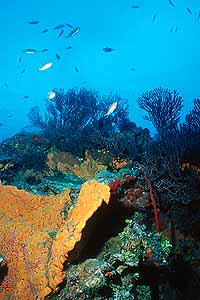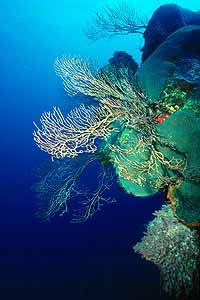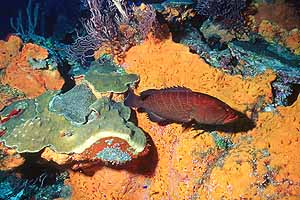 Grand
Cayman Is Alive and Well, After Michelle
Grand
Cayman Is Alive and Well, After Michelle
We feared the worst after hearing stories of massive destruction on Grand Cayman from Hurricane Michelle, but the truth is much kinder. Cayman suffered little damage at all, and the reefs are in great shape.
We arrived in George Town on Wednesday the 12th of December, 2001, a day after we were supposed to arrive due to a missed flight caused by a long sit on the runway in Miami...what is it about Miami International Airport? Every time we fly through that hellhole of mismanagement and incompetence, something goes wrong! Of course, I just answered my own question...
Anyway, we cleared customs & immigration at the George Town airport quickly, dropped off our stuff at the hotel, and headed for a quick afternoon dive. Since we missed both the morning and afternoon dive boats ("thank you, Miami, may I have another?"), we dunked in for a shore dive. Eden Rock seemed a likely place. The first thing I noticed was that hard-pan had been scraped completely clean of coral and sponges; a strange fern-like algae, pale lavender in color, coated the sea floor from the shore out to a depth of maybe 20 feet in place of the usual assortment of sea fans and encrusting sponges. But once we reached the edges of the reef, it was obvious that all was well with Cayman's waters. The only sign I saw of hurricane damage was that some of the tube sponges were half-filled with sand and coral rubble...beyond that, the reef looked great. Lots of fish, big and small, lots of sponges, lots of sea fans, plumes, rods, etc.
We did two shore dives on Thursday: Dive Tech / Turtle Farm, and Sunset House. The Turtle Farm itself is trashed (see below), and Sunset House itself is not in great shape either, but the reefs are both OK. I had looked forward to trying Dive Tech's "West Bay Express" dive, a scooter dive from their Cobalt Coast location down to their Turtle Farm location, but the hurricane damaged their chase boat and they can't resume offering that dive until the boat is fixed. They did not offer an estimate of when the dive would be available again. Bummer. Sunset House's house reef was in perfect shape, as was the semi-famous Mermaid statue.
The damage from Hurricane Michelle seems to be confined to structures that were right on the water, and then only along West Bay. Once you cross Church Street, no damage is visible at all. But structures within 50 feet of the water were pounded pretty hard. The Blue Parrot restaurant at Coconut Harbor is gone. "Gone," as in "there's nothing left but a bare concrete pad." Cocunut Harbor itself showed little damage except to the rooms on the end of the building nearest the ocean -- those rooms have been gutted. The Treasure Island Divers dive shop at Coconut Harbor is still standing, but the shop was not operational while we were there. Several of Sunset House's buildings that were close to the beach are gone....and the pitiful remnants of the Turtle Farm are depressing. Dive Tech's facilities were completely flooded, but they have rebuild quickly. The Cracked Conch is still recovering, but they are open for business.
It seems that the hurricane huffed and puffed but didn't blow down any houses. The Caymanians say that all of the damage actually came from a single 45- or 50-foot wave that screamed up the beach and drenched everything -- from above. I suspect that the resulting backwash completed the demolition.
Enough hurricane talk.
Ian arrived "home" on Grand Cayman on Thursday evening, and was ready for a dive right away. The conditions were right for the Pedro's Castle shore dive, which Ian claims is the best dive on Grand Cayman, and one available for diving only infrequently. Dive operators don't like to take their boats there because it's in the middle of the island on the south side (the dive operators generally keep their boats in the West Bay area, the North Sound, or the East End), which makes it an expensive drive for them. As a shore dive, weather and seas make the site inaccessible for all but a handful of days every year...But Friday it looked passable, so Ian and I suited up, trucked out, and gave it a try.
Getting to the dive site involves knowing exactly where to turn off the road, and where to park. Then you have to suit up with all of your gear and hump it a couple of hundred yards across uneven and sloping ironshore, climb down a small cliff, and walk out on a smooth (i.e. slippery) rock ledge, where you can giant stride into 20 feet of water. Then the surface swim starts, about 10 minutes of finning out to deeper water. When the water reaches 60 feet there's a giant coral head that is the signpost for the start of the dive. Once on the bottom, there's another couple of minutes of swimming before you reach the Main Attraction.
The Main Attraction is a series of huge pinnacles that reach up from the bottom. They tower from 150-200 foot water up to a depth of maybe 60-70 feet, with sand chutes all around them and sea fans and sponges reaching into the current. Huge groupers patrol the area, along with lots of barracuda and thousands upon thousands of smaller fish. This site reminded me very strongly of Cozumel's Palancar dive sites, with uncounted hordes of swimthroughs and overhangs dotting "the wall," and deep blue sea on the other side. Unfortunately for us (and many divers, I suspect), the strenuous effort required to get to the site, coupled with the relative depth (plan on 100 to 110 FSW, minimum), means an all-too-short bottom time. We managed about 20 minutes on the pinnacles before we were low on air and no-deco time.
We ascended to 50 feet for the swim back to shore, which took 10 to 15 minutes. Even with the "right conditions," there was plenty of surge to deal with, which made the swim back in sort of "entertaining." The exit from this dive site is entertaining in its own right; at the aforementioned smooth rock, someone has drilled in what looks like a railroad spike. The spike is located right at the edge of the rock; you climb up the ironshore "cliff" submerged under the rock, grab the spike, and use it to pull yourself the rest of the way up onto the rock. The spike is definitely convenient, but it's also a good indication of what a challenge this dive site is. Of course, Ian waited until we had started our surface swim out to the start of the dive (and after I had accidentally ingested a huge mouthful of seawater through my snorkel!) to tell me that he considered it the most advanced / challenging dive on the island. Thanks, Ian! :)
Saturday we did more shore diving, jumping in at Seaview and the former Blue Parrot restaurant. Both dives exhibited the same scraped-clean hardpan but healthy reefs. I won't go into details on these dives, as I have covered Blue Parrot in previous trip reports, and Seaview is part the same reef system.
 Sunday we finally got on a boat and dove the
North Wall: Hammerhead Hill and Chinese Wall. Both are awesome
dive sites, with a sheer wall that drops to ridiculous depths
(i.e. the Cayman Trench). Of the two, I preferred Hammerhead
Hill slightly because of more numerous gorgonians and
sponges...but Chinese Wall has some great swimthroughs and sand
chutes. If you did Chinese Wall as the first dive, it would
probably be just as good as Hammerhead Hill. I also saw a new
species of fish (well, new to me, anyway) at Hammerhead Hill. I
spotted a small concentration of fairy basslets and swam over to have
a closer look because they had an odd coloration. They were solid
blue, and a very dark blue at that. They had the 'swoosh' through the
eye and the spot on the dorsal fin, but the tail end of the fish was not
bright yellow! I stayed around for a while to get a longer look at
what I assumed was just another color phase of fairy
basslets...Imagine my surprise to discover later that day that they
were blackcap basslets instead!
Sunday we finally got on a boat and dove the
North Wall: Hammerhead Hill and Chinese Wall. Both are awesome
dive sites, with a sheer wall that drops to ridiculous depths
(i.e. the Cayman Trench). Of the two, I preferred Hammerhead
Hill slightly because of more numerous gorgonians and
sponges...but Chinese Wall has some great swimthroughs and sand
chutes. If you did Chinese Wall as the first dive, it would
probably be just as good as Hammerhead Hill. I also saw a new
species of fish (well, new to me, anyway) at Hammerhead Hill. I
spotted a small concentration of fairy basslets and swam over to have
a closer look because they had an odd coloration. They were solid
blue, and a very dark blue at that. They had the 'swoosh' through the
eye and the spot on the dorsal fin, but the tail end of the fish was not
bright yellow! I stayed around for a while to get a longer look at
what I assumed was just another color phase of fairy
basslets...Imagine my surprise to discover later that day that they
were blackcap basslets instead!
North Wall isn't always available for diving, so I definitely recommend diving it if the opportunity presents itself.
I thought Sunday was going to be our last day, but Monday dawned and we the dive operator moved his boat back to West Bay, home of one of my all-time favorite dive sites: Orange Canyon.
Orange Canyon is one of several closely-spaced dive sites at the north end of the West Bay. What makes it special is the reason for its name: an incredible concentration of orange elephant-ear sponges on several adjacent pinnacles. The pinnacles are close enough together that they feel like a wall with swimthroughs...and the orange sponges line the sides of the spaces between the pinnacles. It really does feel like swimming through an orange canyon. Fish life is plentiful at Orange Canyon as well, as are giant black sea fans reaching into the current, which is common.

One of Orange Canyon's Many Sponges
Our second dive on Monday was at Aquarium, a shallow site in West Bay that has one of the highest concentrations of fish I have seen in the Caribbean. Aquarium also has great variety of coral, along with sponges, fans, etc. It's one of the best shallow-water dives I have ever done.
We finished Monday at Stingray City, but I don't have the film from that yet. More later.
Grand Cayman definitely shows some scars from Michelle, but most of the damage seems to be confined to man-made things. The reefs are in great shape.
